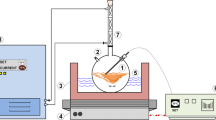Abstract
Lipase fromCandida rugosa catalyzed the hydrolysis of inedible beef tallow and pork lard (edible and inedible) in the presence of organic solvents at temperatures below the melting point of the fat. Reactions were carried out at 50% substrate with 180 lipase units per gram of fat in a two-liter reactor. In the presence of isooctane (5-10%) beef tallow yielded 94% hydrolysis in 24 hr both at 37° and 31°C. Edible pork lard yielded 97% hydrolysis under these conditions and at temperatures as low as 25°C, while inedible lard gave hydrolysis intermediate between the other two fats.
Similar content being viewed by others
References
Yamane T., inWorld Conference on Biotechnology for the Fats and Oils Industry, edited by T.H. Applewhite, American Oil Chemists’ Society, Champaign, 1988, p. 17.
Linfield W.M., inIbid., edited by T.H. Applewhite, American Oil Chemists’ Society, Champaign, 1988, p. 131.
Abraham G., and S. Stegink, (eds.),The Biology, Biochemistry and Technology of Lipases, American Oil Chemists’ Society, Champaign, 1989.
Macrae A.R., inWorld Conference on Emerging Technologies in the Oils and Fats Industries, edited by A.R. Baldwin, American Oil Chemists’ Society, Champaign, 1987, p.7.
Kosugi Y., H. Suzuki and T. Funada,Biotechnol. Bioeng. 31:349 (1988).
Che Omar I., N. Nishio and S. Nagai,Agric. Biol. Chem. 51:2145 (1987).
Godtfredsen S.V., inWorld Biotech Report 1988Blenheim Online, London, England, 1988, p. 229.
Sonnet P.E., inThe Biology, Biochemistry and Technology of Lipases, edited by G.C. Abraham, and S. Stegink, American Oil Chemists’ Society, Champaign, 1989, p. 10.
Linfield W.M., D.J. O’Brien, S. Serota and R.A. Barauskas,J. Am. Oil Chem. Soc. 61:1067(1984).
Hirano J., inWorld Conference on Biotechnology for the Fats and Oils Industry, edited by T.H. Applewhite, American Oil Chemists’ Society, Champaign, 1988, p. 211.
Yamané T., T. Funada and S. Ishida,J. Ferment. Technol. 60:517 (1982).
AOCS Official and Tentative Methods, edited by Technical Com- mittee, Champaign, IL, 1987, Method Cd 3a-63.
Hammond E.W., and J.W. Irwin, inHPLC in Food Analysis, edited by R. Macrae, Academic Press, London, England, 1988, pp. 95–132.
Mukataka S., T. Kobayashi, S. Sato and J. Takahashi,J. Ferment. Technol. 65:23 (1987).
Hang S.T., and J.S. Rhee,Biotechnol. Lett. 11:31 (1989).
Mukataka S., T. Kobayashi and J. Takahashi,J. Ferment. Technol. 65:461 (1985).
Kwon D.Y., and J.S. Rhee,Korean J. Food Sci. Technol. 17:490 (1985).
Author information
Authors and Affiliations
About this article
Cite this article
Virto, M.D., Lascaray, J.M., Solozabal, R. et al. Enzymic hydrolysis of animal fats in organic solvents at temperatures below their melting points. J Am Oil Chem Soc 68, 324–327 (1991). https://doi.org/10.1007/BF02657686
Received:
Revised:
Issue Date:
DOI: https://doi.org/10.1007/BF02657686




